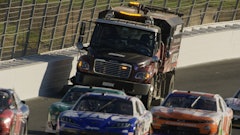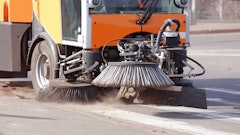
Doesn’t it always seem that in the fall you spend more time dumping and less time sweeping? Those leaves and other yard debris can really add up when you’re trying to get your jobs done on time.
Luckily, there are a few things you can do to prepare your operators and your sweeper for this time of year, and stay productive while you’re at it.
Know What to Expect
In the fall, street gutters fill with leaves, pine cones and pine needles and more. Along with that, the large pile of leaves may contain other foreign objects, such as branches, that are often buried under the leaves and can cause hazards to vehicles. Therefore, Fall sweeping is an extremely essential service. Leaf removal helps improve drainage and reduce catch basin blockages that may cause flooding during the spring snowmelt.
"Never lose sight of the fact that street sweepers are designed to effectively clean streets and highways of normal road debris. They were never designed as high capacity leaf suckers, clam/bucket trucks or front end loaders," says John Paraschak, vice president of sales and marketing at Stewart-Amos.
This is what presents the largest challenge in the fall as sweepers are expected to be miracle workers with the large amounts of debris that is out there. Operators should know what they're up against and how to make the most out of a difficult situation.
“It’s important to increase the sweeping schedule in the fall when leaves are at their peak to maximize payload capacity,” says James Crockett, sweeper products manager, Elgin Sweeper. “This type of debris can be difficult for many sweepers because the material tends to climb over brooms when extremely heavy, making loading difficult.”
So the more frequently you can sweep, the better.
In many areas of the country, fall weather typically also includes rain. Wet leaves are not as easy to pick up as dry leaves. Crockett recommends scheduling your sweeps prior to wet weather or rain events. “Dry leaves are much easier to pick up and can be easily compacted in the sweeper hopper,” he says.
As with any sweeping job, it’s always important to match the right sweeper with the right application.
“Air sweepers are more effective at leaf pickup than mechanical broom sweepers, which tend to mulch the leaves,” Crockett says. “These machines are ideal for removing leaves, pine cones and pine needles from street gutters.”
Tom Rokas with Tymco Sweepers agrees. "A regenerative air street sweeper is the most effective type of sweeper to tackle typical fall cleanup," Rokas says. "Fall is a good time for a regenerative air sweeper to show off, as residents really appreciate the sweeper in the fall season when trees tend to drop the most leaves."
Air sweepers feature a wide pick-up head, large diameter suction hose and the ability to raise/lower the head hydraulically, all things that can make fall cleanup easier on the operator and the machine.
Prepare Your Sweeper
While educating yourself and your operators on what to expect during the heavy fall cleanup is important, preparing your equipment for this type of work is essential to productivity and the health of the equipment.
Check your sweeper manual to see if there is a leaf sweeping setting for the pick-up head on your unit. These settings may not always be enough to handle heavy amounts of leaves. In this case, you can drop the skid plates all the way down in their slots; thereby, raising the pick-up head. Remember to adjust the flotation springs as needed, and keep the pressure bleeder door wide open.
“If the pick-up head is still lacking in the desired performance, the pressure slot openings can be manipulated as a trial-and-error process to maximize the blast air’s performance,” Crockett says.
Set broom contact patterns for proper flicking to increase broom life and ensure a clean, superior sweep, without any debris left behind. Crockett says this is generally, five degrees forward and five degrees left and right. “This is referred to as the 3 o’clock and 10 o’clock positions on the curb side,” he says. “The broom bristles should start out about 12-13 inches long. For optimal flicking action, Elgin Sweeper recommends broom replacement at about 6.5 inches long – about the length of a dollar bill – marked on our “broomstick” ruler.”
Occasionally the pick-up head should be removed to perform a thorough inspection of the pick-up head curtains. “Curtains are vital to the sweeper’s ability to seal the pick-up head to the sweeping surface, ensuring the debris under the head will remain there to be conveyed to the hopper,” Crockett says. “Once the head is out from under the sweeper, turn it over and take note of the condition of the curtains. Any rips, tears, holes, missing sections or deformations will require replacement. Any discrepancies in the curtaining will allow the blast air from a pressure slot to blow material out from under the head, creating a dust cloud as the sweeper travels down the road sweeping.”
It's also a good idea to make sure these rubber flaps or curtains on your sweeping head are not too short. "With leaves, the longer the flaps the better," says Jim Adair director of product management at Schwarze Industries, Inc. "This allows the light weight material to pass into the sweeping head without bunching up or bulldozing in front of the sweep head. Also be sure to open the leaf bleeder just enough to pull the front curtain back, this vacuum keeps the leaves picked up as soon as they come in contact with the head."
Tymco recommends that you always make sure that both the hopper and hopper screen are clean before heading out to sweep. “Starting out with a dirty sweeper will only slow you down as the day wears on,” Rokas says.
"Always start with a clean machine," Adair echos. "Air sweeper need to have a clean intake screen and dust separator. All ducting and passages clear of debris and all fan, intake and door seals intact and making good contact."
Also make sure your hopper water is working properly. This will help the leaves to fall from the air stream and be less likely to stick to the screen.
Optimize Productivity
You can also manage your machine during operation to ensure you’re picking up the most debris possible during your sweep.
"Air sweepers have dampers to exhaust air and inches the vacuum keeping the leaves moving," Adair says. "Mechanical sweepers are not always the best machine for large amount of leaves, but you can adjusted the main broom to a lighter pattern, one to two inches, so that the broom flicks the debris into the conveyor and doesn't pick up and carry it over. Some of our customer recommend using a strip main broom for leaves and some have even gone as far as removing every other strip to prevent the leaves from getting trapped in the broom bristles."
While sweeping, Elgin also recommends that the pressure bleeder door should be wide open while sweeping leaves. Fully opening the pressure bleeder door will allow the front seal curtain to draw up, allowing the leaves to go under the pick-up head much easier.
If the leaves are in large piles, you may have to use the 'Pac Man" trick, recommended by Elgin. Gobble up leaves by raising the pick-up head enough to allow the leaves to pass under, and then lower the head back down on top of the leaves. Repeat as needed. Remember, the pressure bleeder needs to be wide open.
"For best sweeping results any time of the year (but most especially in the fall) ... SLOW DOWN!" Paraschak says. "Give your sweeper sufficient time to sweep or vacuum up heavy leaves and bulky debris. Where is the value/increased productivity associated with sweeping fast if you leave a mess or have to sweep the same street three or four times to get it clean?"
Reducing ground speed prevents overloading. “Don’t be aggressive and “bulldoze” through a large pile of leaves in a single pass," Crockett recommends. "Instead, use a “scalping” method – make two passes with the sweeper instead of one – to help improve productivity.”
Adjusting the sweeper blower RPM accordingly to the debris being swept is also beneficial to the sweep. "Typically with lighter debris such as leaves, you don't need to run the engine RPM as high as when sweeping heavier debris," Rokas says. "If your sweeper is equipped, adjusting the gutter broom tilt with the in-cab controls can be helpful as the correct pitch can be manipulated by the operator to allow the gutter broom to throw the leaves in front of the pick-up head."
Dialing in the gutter broom variable speed can also help ensure a clean sweep when trying to clean up leaves in the fall. Also, using a gutter broom with reduced wire count can ensure a better “bite” on leaf piles when sweeping.
"Never try to sweep a pile higher than your bumper," Paraschak says. "Begin by nibbling away at the pile with your gutter broom and sweep up smaller, more manageable amounts at a time. It may take more passes but you will get the job done without unnecessary clogging and spreading unsightly debris around."
"When sweeping light leaves turn on the front spray bar to increase the mass of the leaves," Paraschak says. "The heavier a leaf is, the easier it is to sweep or vacuum up. If you are operating a regenerative air sweeper, install a pick-up head camera. This camera allows an operator to monitor (in real time) vacuuming performance, spot tiny issues before they become big problems and take corrective action (from the cab) to keep moving forward."
Leaves will blind the screen over once the hopper is full or near full. Sometimes you can shut down the auxiliary engine, wait a moment, then restart the engine; some of the leaves should fall from the screen. If you sweep a little ways and this happens again, it's time to dump.
"Don't forget safety," Adair says "While sweeping large amounts of dry foliage, you’re bound to get some where it shouldn't be. Mainly the hot parts of the engine(s). Be aware of low branches, that when brushed, will leave a deposit of dry leaves sucked into a radiator, oil cooler or atop an exhaust manifold. Keep you machines clean, if you're encountering these conditions, periodically stop and inspect."




![Pavement Awards 2025[main]](https://img.forconstructionpros.com/files/base/acbm/fcp/image/2024/05/PavementAwards_2025_main_.665883e4276e8.png?auto=format%2Ccompress&bg=fff&fill-color=fff&fit=fill&h=100&q=70&w=100)
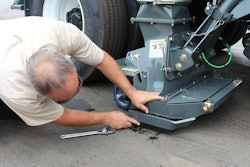
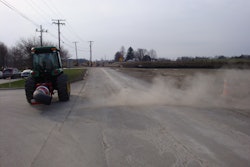



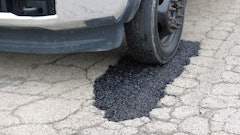


![Pavement Awards 2025[main]](https://img.forconstructionpros.com/files/base/acbm/fcp/image/2024/05/PavementAwards_2025_main_.665883e4276e8.png?ar=16%3A9&auto=format%2Ccompress&bg=fff&fill-color=fff&fit=fill&h=135&q=70&w=240)



